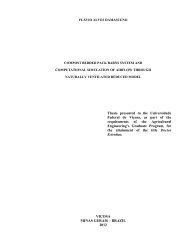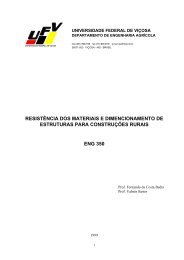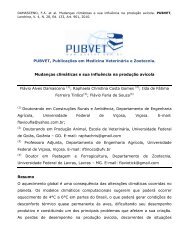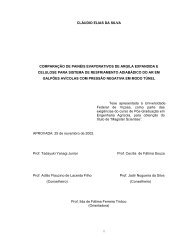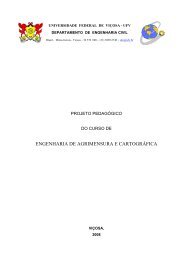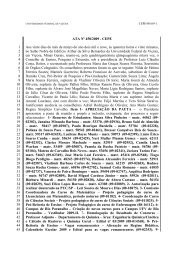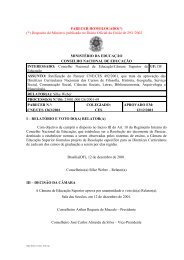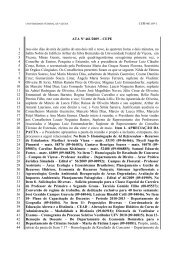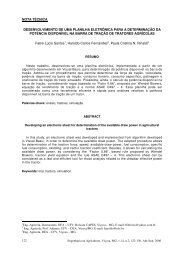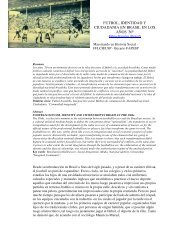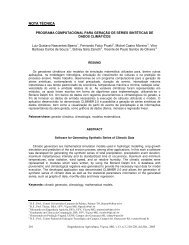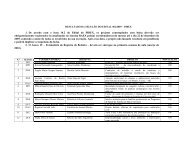ALKALOID BIOSYNTHESIS IN PLANTS: Biochemistry, Cell ... - UFV
ALKALOID BIOSYNTHESIS IN PLANTS: Biochemistry, Cell ... - UFV
ALKALOID BIOSYNTHESIS IN PLANTS: Biochemistry, Cell ... - UFV
You also want an ePaper? Increase the reach of your titles
YUMPU automatically turns print PDFs into web optimized ePapers that Google loves.
36 FACCH<strong>IN</strong>I<br />
45 µM and 37 µM, respectively), and weakly inhibited by tryptamine, secologanin,<br />
and vindoline (28%, 25%, and 40% inhibition, respectively, at 500 µM),<br />
suggesting that DAT activity is modulated by pathway precursors and products<br />
(135). The original purification of DAT led to the incorrect conclusion that the<br />
enzyme consists of two subunits with molecular weights of 33 and 21 kDa. However,<br />
the isolated DAT gene encodes a 50-kDa polypeptide, suggesting that the<br />
protein was cleaved as an artifact of purification (164). Moreover, the protein that<br />
cross-reacts with anti-DAT antibody in seedlings and leaves also has a molecular<br />
weight of 50 kDa (164).<br />
Benzylisoquinoline Alkaloids<br />
Benzylisoquinoline alkaloids (BIAs) are a large and diverse alkaloid group with<br />
∼2500 defined structures. The pharmacological activity of BIAs renders many of<br />
them useful as pharmaceuticals and is often a clue to their biological role in the plant<br />
(19). For example, the effectiveness of morphine as an analgesic, colchicine as a<br />
microtubule disrupter, and (+)-tubocurarine as a neuromuscular blocker suggests<br />
that these alkaloids function as herbivore deterrents. The antimicrobial properties<br />
of sanguinarine suggest that it confers protection against pathogens. The BIAs<br />
berberine, sanguinarine, and palmatine were specifically shown to confer protection<br />
against herbivores and pathogens (149).<br />
BIA biosynthesis begins with a metabolic lattice of decarboxylations, orthohydroxylations,<br />
and deaminations that convert tyrosine to both dopamine and 4hydroxyphenylacetaldehyde<br />
(142). The only enzyme involved in these early steps<br />
that has been purified (100), and for which the corresponding cDNA has been<br />
cloned (38, 98), is the aromatic L-amino acid decarboxylase (TYDC) that converts<br />
tyrosine and dopa to their corresponding amines (Figure 2). TYDC is encoded<br />
by a family of ∼15 genes in Papaver somniferum (opium poppy) that can be<br />
divided into two subgroups based on sequence identity (38). Although the catalytic<br />
properties of the isoforms are similar, each TYDC subfamily exhibits a distinct<br />
developmental and inducible expression pattern (38, 40). TYDC cDNAs have<br />
also been reported from parsley (80) and Arabidopsis thaliana (172), which do not<br />
accumulate tyrosine-derived alkaloids. TYDC mRNAs were shown to be rapidly<br />
induced in response to elicitor treatment (40, 80, 172) and pathogen challenge<br />
(150) in various plants. Induction of TYDC mRNAs in parsley and Arabidopsis<br />
suggests that tyramine serves as the precursor to a ubiquitous class of defenseresponse<br />
metabolites, in addition to BIAs. Recent studies suggest that the synthesis<br />
and deposition in the cell wall of amides, composed of hydroxycinnamic acidderivatives<br />
and tyramine, is central to the defense-response of many plants (105).<br />
Amides, together with other phenolics, are believed to reduce cell wall digestibility.<br />
The dual role of tyramine as a precursor for BIA and hydroxycinnamic acid amide<br />
biosynthesis suggests that the TYDC gene family in opium poppy encodes TYDC<br />
isoforms with diverse metabolic roles.



